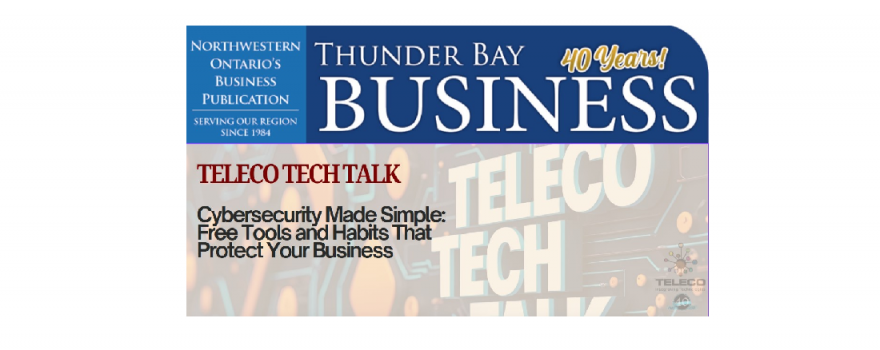
Cybersecurity Made Simple: Free Tools and Habits That Protect Your Business – When it comes to cybersecurity, many small businesses assume protection requires complex tools or expensive software. However, the truth is that there are simple, free actions you can take today to improve your business’s digital safety significantly. Here are some practical (and free!) ways to boost your cyber defences—starting now. Use a Password Manager – A strong password is your first line of defence—but creating and remembering dozens of long, unique, complex passwords? That’s nearly impossible without help. A password manager securely stores and auto-fills passwords for all your accounts
Teleco Tech Talk: Cybersecurity Made Simple: Free Tools and Habits That Protect Your Business
When it comes to cybersecurity, many small businesses assume protection requires complex tools or expensive software. However, the truth is that there are simple, free actions you can take today to improve your business’s digital safety significantly.
Here are some practical (and free!) ways to boost your cyber defences—starting now.
Use a Password Manager
A strong password is your first line of defence—but creating and remembering dozens of long, unique, complex passwords? That’s nearly impossible without help.
A password manager securely stores and auto-fills passwords for all your accounts. These tools can generate strong, hard-to-crack passwords and store them behind a single, strong master password. It will also seamlessly sync between your mobile device and laptop, so you can access and update when and where you need to. It’s a straightforward way to enhance security without compromising convenience.
Learn to Spot Phishing Emails
Phishing is one of the most common threats facing businesses today. Hackers often disguise emails to trick you into clicking malicious links or downloading harmful files.
Educate your team with easy-to-remember tips:
· Always hover over links before clicking (check the destination).
· Look for misspellings, strange grammar, or unusual greetings.
· Be cautious with urgent messages demanding immediate action.
· Verify unexpected attachments by contacting the sender directly.
Think Before You Click
A single careless click can lead to a full-scale breach. Make it a habit to pause before opening links or downloading files—especially from unknown sources. Encouraging a “think-first” culture can prevent most malware and phishing threats.
Enable Two-Factor Authentication (2FA)
Adding a second layer of security—like a one-time code sent to your phone—makes it much harder for attackers to access your accounts, even if they guess your password. Many platforms offer this for free (Google, Microsoft, and most banking apps). Make it a practice to enable two-factor authentication (2FA) for all applications.
Regularly Update Software and Devices
Updates often include security patches that protect you from known vulnerabilities. Set your devices and applications to auto-update whenever possible—it costs nothing and can block major threats.
Keep Cybersecurity Top of Mind
Security awareness isn’t a one-time task. Consider starting a monthly 5-minute “Cyber Safety Moment” at team meetings. Keep it light, practical, and relevant. Use posters, share quick tips, and encourage employees to ask questions.
Cybersecurity doesn’t have to be complicated or costly. These easy steps can significantly reduce your risk and create a culture of cyber awareness in your workplace.
